2019 Hyundai Tucson tow
[x] Cancel search: towPage 334 of 685
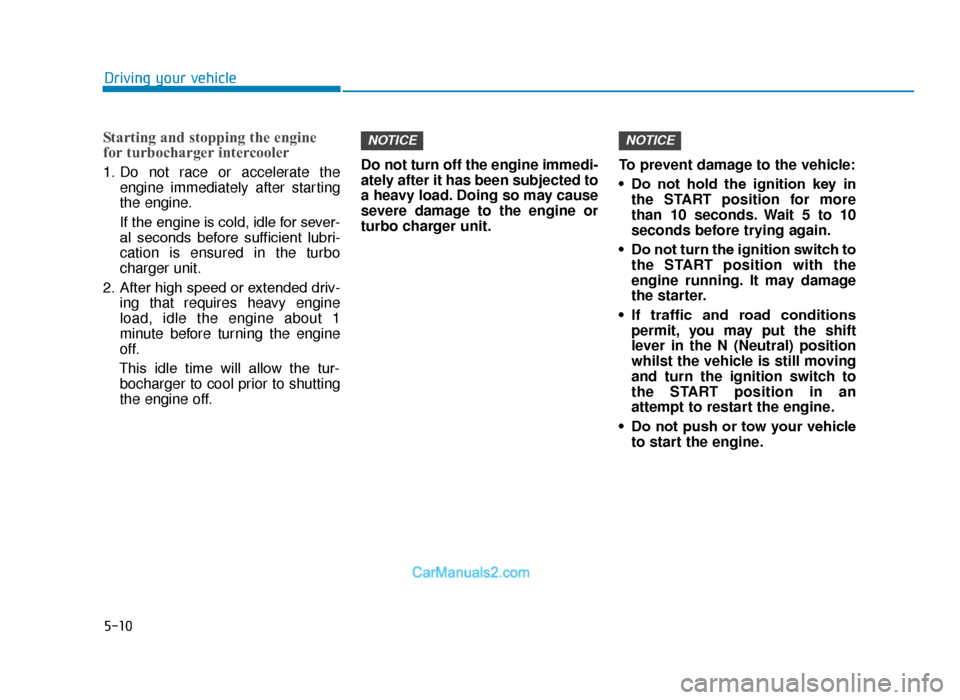
5-10
Driving your vehicle
Starting and stopping the engine
for turbocharger intercooler
1. Do not race or accelerate theengine immediately after starting
the engine.
If the engine is cold, idle for sever-
al seconds before sufficient lubri-
cation is ensured in the turbo
charger unit.
2. After high speed or extended driv- ing that requires heavy engine
load, idle the engine about 1
minute before turning the engine
off.
This idle time will allow the tur- bocharger to cool prior to shutting
the engine off. Do not turn off the engine immedi-
ately after it has been subjected to
a heavy load. Doing so may cause
severe damage to the engine or
turbo charger unit.
To prevent damage to the vehicle:
• Do not hold the ignition key in
the START position for more
than 10 seconds. Wait 5 to 10
seconds before trying again.
• Do not turn the ignition switch to the START position with the
engine running. It may damage
the starter.
• If traffic and road conditions permit, you may put the shift
lever in the N (Neutral) position
whilst the vehicle is still moving
and turn the ignition switch to
the START position in an
attempt to restart the engine.
• Do not push or tow your vehicle to start the engine.
NOTICENOTICE
TLe UK 5.qxp 5/10/2018 12:19 PM Page 10
Page 342 of 685
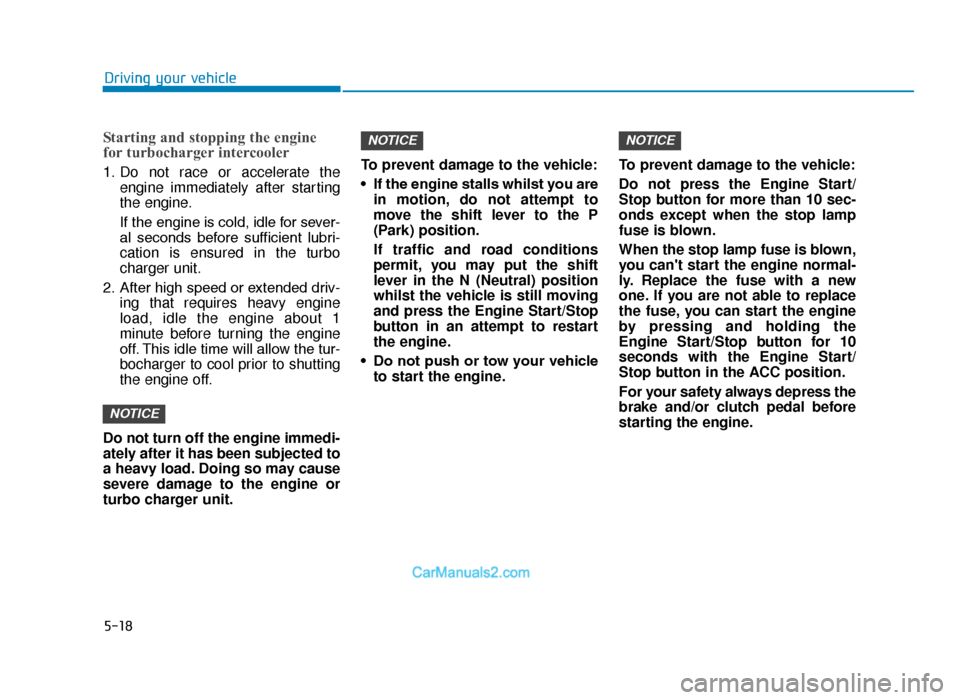
5-18
Driving your vehicle
Starting and stopping the engine
for turbocharger intercooler
1. Do not race or accelerate theengine immediately after starting
the engine.
If the engine is cold, idle for sever-
al seconds before sufficient lubri-
cation is ensured in the turbo
charger unit.
2. After high speed or extended driv- ing that requires heavy engine
load, idle the engine about 1
minute before turning the engine
off. This idle time will allow the tur-
bocharger to cool prior to shutting
the engine off.
Do not turn off the engine immedi-
ately after it has been subjected to
a heavy load. Doing so may cause
severe damage to the engine or
turbo charger unit. To prevent damage to the vehicle:
• If the engine stalls whilst you are
in motion, do not attempt to
move the shift lever to the P
(Park) position.
If traffic and road conditions
permit, you may put the shift
lever in the N (Neutral) position
whilst the vehicle is still moving
and press the Engine Start/Stop
button in an attempt to restart
the engine.
• Do not push or tow your vehicle to start the engine. To prevent damage to the vehicle:
Do not press the Engine Start/
Stop button for more than 10 sec-
onds except when the stop lamp
fuse is blown.
When the stop lamp fuse is blown,
you can't start the engine normal-
ly. Replace the fuse with a new
one. If you are not able to replace
the fuse, you can start the engine
by pressing and holding the
Engine Start/Stop button for 10
seconds with the Engine Start/
Stop button in the ACC position.
For your safety always depress the
brake and/or clutch pedal before
starting the engine.
NOTICENOTICE
NOTICE
TLe UK 5.qxp 5/10/2018 12:19 PM Page 18
Page 372 of 685
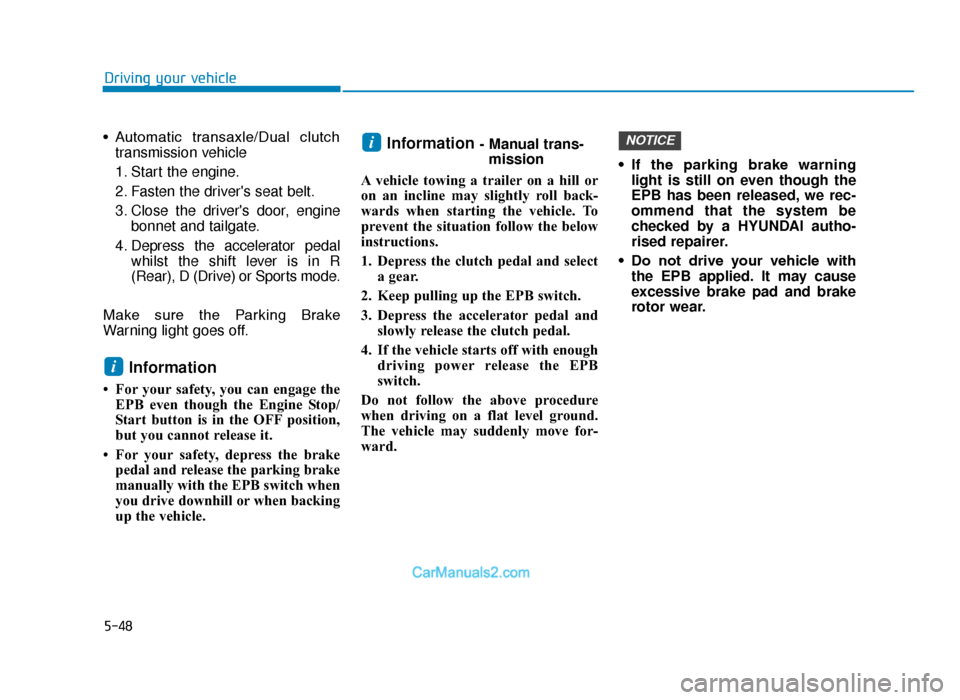
5-48
Driving your vehicle
• Automatic transaxle/Dual clutch transmission vehicle
1. Start the engine.
2. Fasten the driver's seat belt.
3. Close the driver's door, engine bonnet and tailgate.
4. Depress the accelerator pedal whilst the shift lever is in R
(Rear), D (Drive) or Sports mode.
Make sure the Parking Brake
Warning light goes off.
Information
• For your safety, you can engage the EPB even though the Engine Stop/
Start button is in the OFF position,
but you cannot release it.
• For your safety, depress the brake pedal and release the parking brake
manually with the EPB switch when
you drive downhill or when backing
up the vehicle.
Information - Manual trans-mission
A vehicle towing a trailer on a hill or
on an incline may slightly roll back-
wards when starting the vehicle. To
prevent the situation follow the below
instructions.
1. Depress the clutch pedal and select a gear.
2. Keep pulling up the EPB switch.
3. Depress the accelerator pedal and slowly release the clutch pedal.
4. If the vehicle starts off with enough driving power release the EPB
switch.
Do not follow the above procedure
when driving on a flat level ground.
The vehicle may suddenly move for-
ward. • If the parking brake warning
light is still on even though the
EPB has been released, we rec-
ommend that the system be
checked by a HYUNDAI autho-
rised repairer.
• Do not drive your vehicle with the EPB applied. It may cause
excessive brake pad and brake
rotor wear.NOTICEi
i
TLe UK 5.qxp 5/10/2018 12:21 PM Page 48
Page 373 of 685

5-49
Driving your vehicle
5
When the EPB (Electronic Parking
Brake) does not release:
We recommend that you contact a
HYUNDAI authorised repairer by
loading the vehicle on a flatbed tow
truck and have the system checked.
EPB (Electronic Parking Brake)
may be automatically applied
when:
• The EPB is overheated
• It is requested by other systems
• The engine is turned off with theEPB applied
Information
If the driver turns the engine off
whilst Auto Hold is operating, EPB
will be automatically applied.
However, if you press the EPB switch
within one second after the engine is
turned off, the EPB will not be
applied.
Warning messages
To release EPB, close door, bonnet
and tailgate and fasten seatbelt
• When you try to drive with the EPBapplied, a warning will sound and a
message will appear.
• If the driver's seat belt is unfas- tened and the engine bonnet or
tailgate is opened, a warning will
sound and a message will appear.
• When there is a problem with the vehicle, a warning may sound and
a message may appear.
If the situation occurs, depress the
brake pedal and release EPB by
pressing the EPB switch.i
OTLE058231
•Whenever leaving the vehicle
or parking, always come to a
complete stop and continue
to depress the brake pedal.
Move the shift lever into the P
(Park) position, press the EPB
switch, and press the Engine
Start/Stop button to the OFF
position. Take the Smart Key
with you when exiting the
vehicle.
Vehicles not fully engaged in
P (Park) with the parking
brake set are at risk for mov-
ing inadvertently and causing
injury to yourself or others.
•NEVER allow anyone who is
unfamiliar with the vehicle to
touch the EPB switch. If the
EPB is released unintentional-
ly, serious injury may occur.
•Only release the EPB when
you are seated inside the
vehicle with your foot firmly
on the brake pedal.
WARNING
TLe UK 5.qxp 5/10/2018 12:21 PM Page 49
Page 376 of 685

5-52
Driving your vehicle
If you continuously notice a noise
or burning smell when the EPB is
used for emergency braking, we
recommend that the system be
checked by a HYUNDAI authorised
repairer.
When the EPB (Electronic Parking
Brake) does not release
If the EPB does not release normal-
ly, we recommend that you contact a
HYUNDAI authorised repairer by
loading the vehicle on a flatbed tow
truck and have the system checked.
AUTO HOLD (if equipped)
This feature keeps the brake applied
when the shift lever is in D (Drive), R
(Reverse), N (Neutral) or Sports
Mode with the feature enabled and
when the brake pedal has been
depressed to stop the vehicle.
To apply :
1. With the driver's door, engine bon- net and tailgate closed, fasten the
driver's seat belt or depress the
brake pedal and then press the
[AUTO HOLD] switch. The white
AUTO HOLD indicator will come
on and the system will be in the
standby position.
NOTICE
OTLE055018R
W
Whhiittee
TLe UK 5.qxp 5/10/2018 12:22 PM Page 52
Page 392 of 685
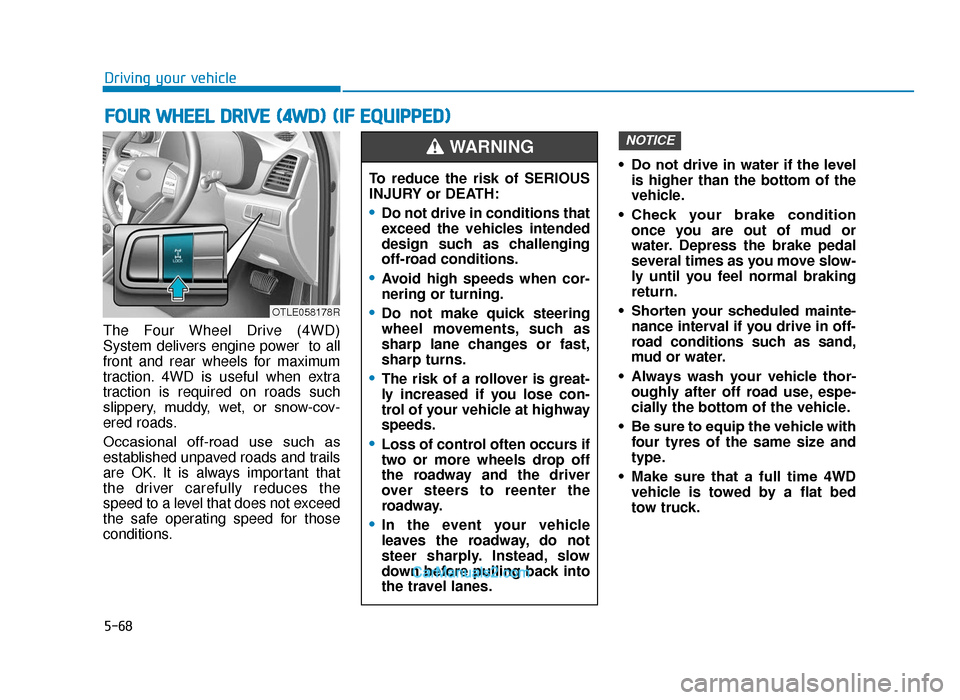
5-68
Driving your vehicle
The Four Wheel Drive (4WD)
System delivers engine power to all
front and rear wheels for maximum
traction. 4WD is useful when extra
traction is required on roads such
slippery, muddy, wet, or snow-cov-
ered roads.
Occasional off-road use such as
established unpaved roads and trails
are OK. It is always important that
the driver carefully reduces the
speed to a level that does not exceed
the safe operating speed for those
conditions. • Do not drive in water if the level
is higher than the bottom of the
vehicle.
• Check your brake condition once you are out of mud or
water. Depress the brake pedal
several times as you move slow-
ly until you feel normal braking
return.
• Shorten your scheduled mainte- nance interval if you drive in off-
road conditions such as sand,
mud or water.
• Always wash your vehicle thor- oughly after off road use, espe-
cially the bottom of the vehicle.
• Be sure to equip the vehicle with four tyres of the same size and
type.
• Make sure that a full time 4WD vehicle is towed by a flat bed
tow truck.
NOTICE
FOUR WHEEL DRIVE (4WD) (IF EQUIPPED)
To reduce the risk of SERIOUS
INJURY or DEATH:
•Do not drive in conditions that
exceed the vehicles intended
design such as challenging
off-road conditions.
•Avoid high speeds when cor-
nering or turning.
•Do not make quick steering
wheel movements, such as
sharp lane changes or fast,
sharp turns.
•The risk of a rollover is great-
ly increased if you lose con-
trol of your vehicle at highway
speeds.
•Loss of control often occurs if
two or more wheels drop off
the roadway and the driver
over steers to reenter the
roadway.
•In the event your vehicle
leaves the roadway, do not
steer sharply. Instead, slow
down before pulling back into
the travel lanes.
WARNING
OTLE058178R
TLe UK 5.qxp 5/10/2018 12:23 PM Page 68
Page 397 of 685

5-73
Driving your vehicle
5
• Always hold the steering wheelfirmly when you are driving off-
road.
Emergency precautions
Tyres
Do not use tyre and wheel with dif-
ferent size and type from the one
originally installed on your vehicle. It
can affect the safety and perform-
ance of your vehicle, which could
lead to steering failure or rollover
causing serious injury.
When replacing the tyres, be sure to
equip all four tyres with the tyre and
wheel of the same size, type, tread,
brand and load-carrying capacity. If
you equip your vehicle with any
tyre/wheel combination not recom-
mended by HYUNDAI for off-road
driving, you should not use these
tyres for highway driving.
Towing
4WD vehicles must be towed with a
wheel lift and dollies or flatbed equip-
ment with all the wheels off the
ground. For more details, refer to
"Towing" in chapter 6.
Dynamometer testing
A full-time 4WD vehicle must be test-
ed on a special four wheel chassis
dynamometer.
OTLE055003
Do not grab the inside of the
steering wheel when you are
driving off-road. You may hurt
your arm by a sudden steering
bonnet or from steering wheel
rebound due to an impact with
objects on the ground. You
could lose control of the steer-
ing wheel which may lead to
serious injury or death.
WARNING
Never start or run the engine
whilst a full-time 4WD vehicle is
raised on a jack. The vehicle can
slip or roll off of a jack causing
serious injury or death to you or
those nearby.
WARNING
TLe UK 5.qxp 5/10/2018 12:23 PM Page 73
Page 417 of 685
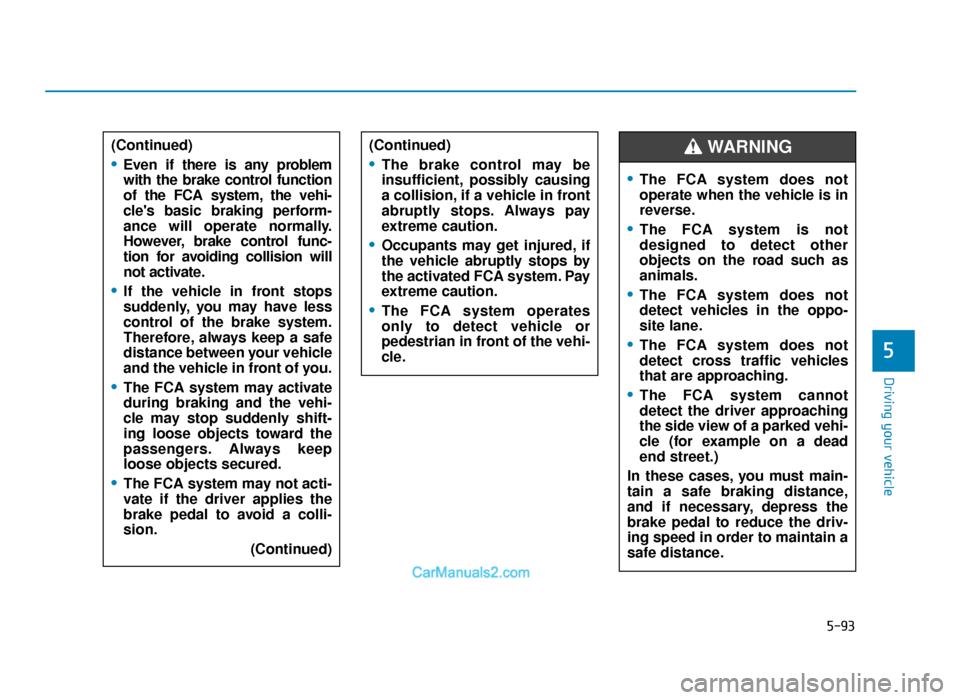
5-93
Driving your vehicle
5
(Continued)
•Even if there is any problem
with the brake control function
of the FCA system, the vehi-
cle's basic braking perform-
ance will operate normally.
However, brake control func-
tion for avoiding collision will
not activate.
•If the vehicle in front stops
suddenly, you may have less
control of the brake system.
Therefore, always keep a safe
distance between your vehicle
and the vehicle in front of you.
•The FCA system may activate
during braking and the vehi-
cle may stop suddenly shift-
ing loose objects toward the
passengers. Always keep
loose objects secured.
•The FCA system may not acti-
vate if the driver applies the
brake pedal to avoid a colli-
sion.(Continued)
(Continued)
•The brake control may be
insufficient, possibly causing
a collision, if a vehicle in front
abruptly stops. Always pay
extreme caution.
•Occupants may get injured, if
the vehicle abruptly stops by
the activated FCA system. Pay
extreme caution.
•The FCA system operates
only to detect vehicle or
pedestrian in front of the vehi-
cle.
•The FCA system does not
operate when the vehicle is in
reverse.
•The FCA system is not
designed to detect other
objects on the road such as
animals.
•The FCA system does not
detect vehicles in the oppo-
site lane.
•The FCA system does not
detect cross traffic vehicles
that are approaching.
•The FCA system cannot
detect the driver approaching
the side view of a parked vehi-
cle (for example on a dead
end street.)
In these cases, you must main-
tain a safe braking distance,
and if necessary, depress the
brake pedal to reduce the driv-
ing speed in order to maintain a
safe distance.
WARNING
TLe UK 5.qxp 5/10/2018 12:25 PM Page 93